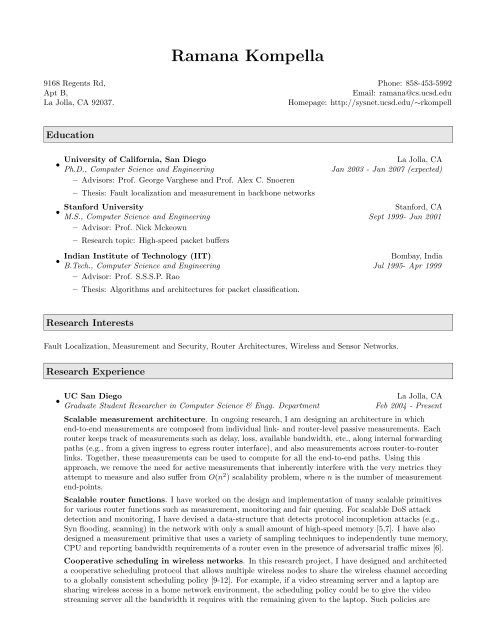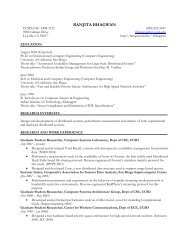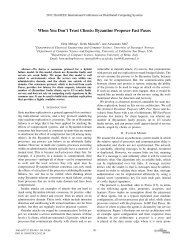Ramana Kompella - Systems and Networking Group - UC San Diego
Ramana Kompella - Systems and Networking Group - UC San Diego
Ramana Kompella - Systems and Networking Group - UC San Diego
You also want an ePaper? Increase the reach of your titles
YUMPU automatically turns print PDFs into web optimized ePapers that Google loves.
<strong>Ramana</strong> <strong>Kompella</strong><br />
9168 Regents Rd, Phone: 858-453-5992<br />
Apt B,<br />
Email: ramana@cs.ucsd.edu<br />
La Jolla, CA 92037.<br />
Homepage: http://sysnet.ucsd.edu/∼rkompell<br />
Education<br />
University of California, <strong>San</strong> <strong>Diego</strong><br />
•<br />
Ph.D., Computer Science <strong>and</strong> Engineering<br />
– Advisors: Prof. George Varghese <strong>and</strong> Prof. Alex C. Snoeren<br />
– Thesis: Fault localization <strong>and</strong> measurement in backbone networks<br />
La Jolla, CA<br />
Jan 2003 - Jun 2007 (expected)<br />
Stanford University<br />
Stanford, CA<br />
•<br />
M.S., Computer Science <strong>and</strong> Engineering Sept 1999- Jun 2001<br />
– Advisor: Prof. Nick Mckeown<br />
– Research topic: High-speed packet buffers<br />
Indian Institute of Technology (IIT)<br />
Bombay, India<br />
•<br />
B.Tech., Computer Science <strong>and</strong> Engineering Jul 1995- Apr 1999<br />
– Advisor: Prof. S.S.S.P. Rao<br />
– Thesis: Algorithms <strong>and</strong> architectures for packet classification.<br />
Research Interests<br />
Fault Localization, Measurement <strong>and</strong> Security, Router Architectures, Wireless <strong>and</strong> Sensor Networks.<br />
Research Experience<br />
<strong>UC</strong> <strong>San</strong> <strong>Diego</strong><br />
•<br />
Graduate Student Researcher in Computer Science & Engg. Department<br />
La Jolla, CA<br />
Feb 2004 - Present<br />
Scalable measurement architecture. In ongoing research, I am designing an architecture in which<br />
end-to-end measurements are composed from individual link- <strong>and</strong> router-level passive measurements. Each<br />
router keeps track of measurements such as delay, loss, available b<strong>and</strong>width, etc., along internal forwarding<br />
paths (e.g., from a given ingress to egress router interface), <strong>and</strong> also measurements across router-to-router<br />
links. Together, these measurements can be used to compute for all the end-to-end paths. Using this<br />
approach, we remove the need for active measurements that inherently interfere with the very metrics they<br />
attempt to measure <strong>and</strong> also suffer from O(n 2 ) scalability problem, where n is the number of measurement<br />
end-points.<br />
Scalable router functions. I have worked on the design <strong>and</strong> implementation of many scalable primitives<br />
for various router functions such as measurement, monitoring <strong>and</strong> fair queuing. For scalable DoS attack<br />
detection <strong>and</strong> monitoring, I have devised a data-structure that detects protocol incompletion attacks (e.g.,<br />
Syn flooding, scanning) in the network with only a small amount of high-speed memory [5,7]. I have also<br />
designed a measurement primitive that uses a variety of sampling techniques to independently tune memory,<br />
CPU <strong>and</strong> reporting b<strong>and</strong>width requirements of a router even in the presence of adversarial traffic mixes [6].<br />
Cooperative scheduling in wireless networks. In this research project, I have designed <strong>and</strong> architected<br />
a cooperative scheduling protocol that allows multiple wireless nodes to share the wireless channel according<br />
to a globally consistent scheduling policy [9-12]. For example, if a video streaming server <strong>and</strong> a laptop are<br />
sharing wireless access in a home network environment, the scheduling policy could be to give the video<br />
streaming server all the b<strong>and</strong>width it requires with the remaining given to the laptop. Such policies are
difficult to implement using current 802.11 a/b/g wireless devices. The cooperative scheduling protocol uses a<br />
novel 2 1 2<br />
stage pipeline architecture. In this architecture, nodes estimate their traffic requirements, then<br />
exchange this information to agree on a transmission schedule (in terms of number of packets each node can<br />
transmit within the given time frame). However, the channel access itself is regulated through the normal<br />
distributed coordination function (DCF) of the 802.11 protocol.<br />
AT&T Labs - Research<br />
Florham Park, NJ<br />
•<br />
Summer Intern Jun 2004 - Sep 2004 <strong>and</strong> Jun 2005 - Sep 2005<br />
Fault localization. Faults are common in backbone networks; fast <strong>and</strong> accurate fault localization is critical<br />
for both reliability as well as manageability of the network. I have developed a general risk-modeling<br />
methodology that relies on creating dependencies between observable symptoms <strong>and</strong> likely root-causes [1]. In<br />
this methodology, we apply inference algorithms to output a compact <strong>and</strong> accurate set of root-causes for a<br />
given set of observed symptoms. Using this methodology, I have built two systems—link- <strong>and</strong> path-fault<br />
localization systems—that have been deployed in a large tier-I network for over a year.<br />
Stanford University<br />
Stanford, CA<br />
•<br />
Member of High-Performance <strong>Networking</strong> group Jan 2000 - Jun 2001<br />
Fast packet buffers. All packet switches <strong>and</strong> routers require packet buffers to hold packets during<br />
temporary episodes of congestion. As a typical rule of thumb, a buffer size of approximately link speed times<br />
the round-trip time is used in these switches <strong>and</strong> routers. As link speeds increase to OC-768 (40 Gbps) <strong>and</strong><br />
beyond, current SRAM memories are technologically infeasible while DRAM memories are too slow to h<strong>and</strong>le<br />
packet read/writes at wire-speed. In our architecture, we propose a way to combine the DRAM <strong>and</strong> SRAM<br />
memories such that the hybrid memory architecture operates at SRAM speeds but with DRAM capacities<br />
[13,14]. Moreover, our architecture provides deterministic worst case as opposed to statistical guarantees<br />
other approaches provide. The work resulted in a company called Nemo <strong>Systems</strong> acquired by Cisco Inc., in<br />
May 2005.<br />
Industry Experience<br />
Chelsio Communications Inc.<br />
Sunnyvale, CA<br />
•<br />
Member of Technical Staff Dec 2002 - Jan 2004<br />
Hardware TCP engine. At Chelsio, I worked on a 10Gbps TCP hardware engine as an ASIC design <strong>and</strong><br />
verification engineer. I designed <strong>and</strong> implemented modules (in Verilog) for performing direct data placement<br />
<strong>and</strong> remote DMA (using ISCSI <strong>and</strong> IWARP st<strong>and</strong>ards) after terminating TCP sessions in hardware. In<br />
addition, I also invented novel algorithms for performing fast flow identification using a combination of<br />
hashing <strong>and</strong> TCAMs instead of using TCAMs alone.<br />
SwitchOn Networks Inc. (acquired by PMC-Sierra Inc.)<br />
<strong>San</strong>ta Clara, CA<br />
•<br />
Design Engineer Mar 2000 - Oct 2001<br />
Packet classification processor. I was part of the team that designed <strong>and</strong> architected a flexible platform<br />
to perform high speed packet classification called ClassiPI. ClassiPI employed an SIMD (single instruction<br />
multiple data) architecture for performing parallel matching of packet classification rules. However, unlike<br />
power-hungry TCAMs, the architecture effectively combined decision trees <strong>and</strong> hardware parallelism to<br />
reduce the power consumption while remaining comparable to TCAM’s performance. The architectural<br />
details of ClassiPI can be found in the paper I have co-authored with colleagues [16]. The algorithms I have<br />
invented have also resulted in two patents (nos. 6,691,168 <strong>and</strong> 7,043,494).<br />
Teaching Experience<br />
<strong>UC</strong> <strong>San</strong> <strong>Diego</strong><br />
La Jolla, CA<br />
•<br />
CSE 123A Sep 2006 - Dec 2006<br />
– TA for the under-graduate course on computer networks.<br />
– Lead discussion sections on both covered as well as additional lecture material.
Stanford University<br />
Stanford, CA<br />
•<br />
CS 244 Jan 2000 - Mar 2000<br />
– TA for the graduate course on computer networks.<br />
– Lead discussion sections <strong>and</strong> homework reviews.<br />
Publications<br />
Fault Management in Large Scale Networks<br />
1. <strong>Ramana</strong> Rao <strong>Kompella</strong>, Alex C. Snoeren, Jennifer Yates, Albert Greenberg, “Fault Localization via Risk<br />
Modeling”, under review in IEEE/ACM Transactions on <strong>Networking</strong> (ToN).<br />
2. <strong>Ramana</strong> Rao <strong>Kompella</strong>, Alex C. Snoeren, Jennifer Yates, Albert Greenberg, “Detection <strong>and</strong> Localization of<br />
Network Blackholes”, to appear in IEEE Infocom, Alaska, USA, April 2007 (Infocom 2007).<br />
3. <strong>Ramana</strong> Rao <strong>Kompella</strong>, Albert Greenberg, Jennifer Rexford, Alex C. Snoeren, Jennifer Yates, “Cross-layer<br />
visibility as a Service”, in the Proceedings of Fourth ACM Workshop on Hot Topics in Networks, College<br />
Park, MD, Nov 2005 (HotNets 2005).<br />
4. <strong>Ramana</strong> Rao <strong>Kompella</strong>, Jennifer Yates, Albert Greenberg, Alex Snoeren, “IP Fault Localization via Risk<br />
Modeling”, in the Proceedings of the 2nd Symposium on Networked <strong>Systems</strong> Design <strong>and</strong> Implementation,<br />
Boston, May 2005 (NSDI 2005).<br />
Scalable Router Functions (Security, Scheduling, Measurement)<br />
5. <strong>Ramana</strong> Rao <strong>Kompella</strong>, Sumeet Singh, George Varghese, “On scalable attack detection in the Network”, to<br />
appear in IEEE/ACM Transactions on <strong>Networking</strong>, April 2007 (ToN 2007).<br />
6. <strong>Ramana</strong> Rao <strong>Kompella</strong>, Cristian Estan, “The Power of Slicing in Internet Flow Measurement”, in<br />
Proceedings of ACM/USENIX Internet Measurement Conference, Berkeley, CA, October 2005 (IMC 2005).<br />
7. <strong>Ramana</strong> Rao <strong>Kompella</strong>, George Varghese, “Detecting DoS attacks in the Network”, in Proceedings of the 2nd<br />
ACM/USENIX Internet Measurement Conference, Taormina, Sicily, Italy, October 2004 (IMC 2004).<br />
8. <strong>Ramana</strong> Rao <strong>Kompella</strong>, George Varghese, “Reduced state Fair Queuing for Core <strong>and</strong> Edge routers”, in<br />
Proceedings of the 14th ACM International Workshop on Network <strong>and</strong> Operating <strong>Systems</strong> Support for<br />
Digital Audio <strong>and</strong> Video, Kinsale, County Cork, Irel<strong>and</strong>, June 2004 (NOSSDAV 2004).<br />
Wireless <strong>and</strong> Sensor Networks<br />
9. Ishwar Ramani, <strong>Ramana</strong> Rao <strong>Kompella</strong>, Sriram Ramabhadran, Alex C. Snoeren, “Efficient Cooperative<br />
Scheduling in 802.11 Wireless Networks”, <strong>UC</strong>SD Technical Report CS2005-0830, La Jolla, CA, July 2005<br />
(<strong>UC</strong>SD TR 2005)<br />
10. <strong>Ramana</strong> Rao <strong>Kompella</strong>, Sriram Ramabhadran, Ishwar Ramani, Alex C. Snoeren, “Cooperative Scheduling<br />
via pipelining in 802.11 Wireless Networks”, in the Proceedings of ACM SIGCOMM Workshop on<br />
Experimental Approaches to Wireless Network Design <strong>and</strong> Analysis, Philadelphia, PA, August, 2005<br />
(SIGCOMM E-WIND 2005).<br />
11. <strong>Ramana</strong> Rao <strong>Kompella</strong>, Alex C. Snoeren, “Practical Lazy Scheduling in Wireless Sensor Networks”, in<br />
Proceedings of the First Conference on Embedded Sensor <strong>Systems</strong>, November 2003, Los Angeles, California,<br />
USA (SENSYS 2003).<br />
12. <strong>Ramana</strong> Rao <strong>Kompella</strong>, Alex C. Snoeren, “SPARTA : Scheduled Rate <strong>and</strong> Power Adaptation in Wireless<br />
Networks”, Extended Abstract in ACM SIGCOMM, August 2003, Karlsruhe, Germany (SIGCOMM 2003).<br />
Deterministic Memory Designs for High Performance Routers<br />
13. Sundar Iyer, <strong>Ramana</strong> Rao <strong>Kompella</strong>, Nick McKeown, “Designing Buffers for Router Line Cards”, Stanford<br />
University HPNG Technical Report, TR02-HPNG-031001, Stanford. Also under review in IEEE/ACM<br />
Transactions on <strong>Networking</strong>, Nov, 2002 (ToN 2002).
14. Sundar Iyer, <strong>Ramana</strong> Rao <strong>Kompella</strong>, Nick McKeown, “Analysis of Memory Architecture for Fast Packet<br />
Buffers ” in the IEEE Workshop on High Performance Switching <strong>and</strong> Routing, Dallas, May 2001 (HPSR<br />
2001).<br />
15. Sundar Iyer, <strong>Ramana</strong> Rao <strong>Kompella</strong>, Nick McKeown, “Techniques for Fast Packet Buffers”, Gigabit<br />
<strong>Networking</strong> Workshop, Anchorage, Alaska, April, 2001 (GBN 2001).<br />
Packet Classification Architectures<br />
16. Sundar Iyer, <strong>Ramana</strong> Rao <strong>Kompella</strong>, Ajit Shelat, “ClassiPI : An Architecture for Fast <strong>and</strong> Flexible Packet<br />
Classification”, in IEEE Network Special Issue on Fast IP Packet Forwarding <strong>and</strong> Classification for Next<br />
Generation Internet Services”, March-April 2001 (IEEE NETWORK 2001).<br />
Presentations <strong>and</strong> Posters<br />
1. “Cross-layer visibility as a Service”, presentation in Fourth ACM Workshop on Hot Topics in Networks,<br />
College Park, MD, Nov 2005 (HotNets 2005).<br />
2. “The Power of Slicing in Internet Flow Measurement”, presentation in ACM/USENIX Internet Measurement<br />
Conference, Berkeley, CA, October 2005 (IMC 2005).<br />
3. “Cooperative Scheduling via pipelining in 802.11 Wireless Networks”, presentation in ACM SIGCOMM<br />
Workshop on Experimental Approaches to Wireless Network Design <strong>and</strong> Analysis, Philadelphia, PA, August,<br />
2005 (SIGCOMM E-WIND 2005).<br />
4. “IP Fault Localization via Risk Modeling”, presentation in the 2nd Symposium on Networked <strong>Systems</strong> Design<br />
<strong>and</strong> Implementation, Boston, May 2005 (NSDI 2005).<br />
5. “Detecting DoS attacks in the Network”, presentation in 2nd ACM/USENIX Internet Measurement<br />
Conference, Taormina, Sicily, Italy, October 2004 (IMC 2004).<br />
6. “Reduced state Fair Queuing for Core <strong>and</strong> Edge routers”, presentation in 14th ACM International Workshop<br />
on Network <strong>and</strong> Operating <strong>Systems</strong> Support for Digital Audio <strong>and</strong> Video, Kinsale, County Cork, Irel<strong>and</strong>,<br />
June 2004 (NOSSDAV 2004).<br />
7. “Practical Lazy Scheduling in Wireless Sensor Networks”, presentation in the First Conference on Embedded<br />
Sensor <strong>Systems</strong>, November 2003, Los Angeles, California, USA (SENSYS 2003).<br />
8. “SPARTA : Scheduled Rate <strong>and</strong> Power Adaptation in Wireless Networks”, Poster presentation in ACM<br />
SIGCOMM, August 2003, Karlsruhe, Germany (SIGCOMM 2003).<br />
Patents (Pending <strong>and</strong> Issued)<br />
1. “IP Fault Localization via Risk Modeling”, with Jennifer Yates, Alex C. Snoeren, Albert Greenberg, (Pending<br />
- Filed Nov 2005).<br />
2. “Fast, Deterministic Exact Match Look-ups In Large Tables”, with Deepali Joshi, Ajit Shelat, Amit<br />
Phansalkar, Sundar Iyer <strong>and</strong> George Varghese, (Patent No. 7,043,494 - issued May 9, 2006).<br />
3. “Method <strong>and</strong> Apparatus for High-Speed Network Rule Processing”, with Sundar Iyer, Moti Ji<strong>and</strong>ani, Ajit<br />
Shelat et al, (Patent No. 6,691,168, issued Feb 10, 2004).<br />
4. “Implementing Lookup Methods, with bounded deterministic delay, using only content addressable memory<br />
<strong>and</strong> hashing techniques”, with Asgeir Eiriksson, Chelsio Communications Inc. (Pending - Filed Jun 2002).<br />
5. “Algorithm <strong>and</strong> Design for Deterministic Route Lookups”, with Sundar Iyer, Ajit Shelat, George Varghese,<br />
PMC Inc., (Pending - Filed Jul 2001).
Awards <strong>and</strong> Grants<br />
• Graduate Student Researcher position since January 2003.<br />
• Travel grant to present poster in ACM SIGCOMM 2003, Karlsruhe, Germany.<br />
• Travel grant to visit ACM NOSSDAV 2004, Kinsale, Irel<strong>and</strong>.<br />
• Travel grant to visit ACM/USENIX NSDI 2005, Boston, MA.<br />
• Top 0.07% among more than 100,000 examinees in the Joint Entrance Examination (JEE) for entrance into<br />
the Indian Institutes of Technology (IIT).<br />
Professional activities<br />
• Program Committee Member of Mock SIGCOMM 2006 held at University of California, <strong>San</strong> <strong>Diego</strong>, April<br />
2006.<br />
• Reviewer for major networking <strong>and</strong> systems conferences including ACM SOSP, ACM/USENIX NSDI,<br />
USENIX OSDI, ACM SIGCOMM, IEEE ICC, IEEE Infocom, IEEE/ACM Transactions on <strong>Networking</strong>,<br />
IEEE Transactions on Dependable <strong>and</strong> Secure Computing.<br />
References<br />
Prof. George Varghese<br />
Professor, Dept. of Computer Science <strong>and</strong> Engineering,<br />
University of California, <strong>San</strong> <strong>Diego</strong>,<br />
EBU3B 3130<br />
9500 Gilman Drive, M/C 0404<br />
La Jolla, CA 92093-0404<br />
Email: varghese@cs.ucsd.edu<br />
Phone: (858) 822 0424<br />
Prof. Alex C. Snoeren,<br />
Assistant Professor, Dept. of Computer Science <strong>and</strong><br />
Engineering,<br />
University of California, <strong>San</strong> <strong>Diego</strong>,<br />
EBU3B 3114<br />
9500 Gilman Drive, M/C 0404<br />
La Jolla, CA 92093-0404<br />
Email: snoeren@cs.ucsd.edu<br />
Phone: (858) 822 2289<br />
Dr. Albert Greenberg<br />
AT&T Labs - Research<br />
Room A161; Building 103<br />
180 Park Avenue<br />
Florham Park, NJ 07932<br />
Email: albert.greenberg@hotmail.com<br />
Phone: (201) 404 4756<br />
Dr. Jennifer Yates<br />
AT&T Labs - Research<br />
Building 103<br />
180 Park Avenue<br />
Florham Park, NJ 07932<br />
Email: jyates@research.att.com<br />
Phone: (973) 360 7036






